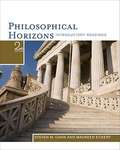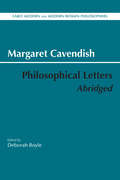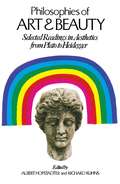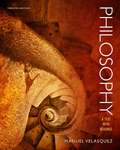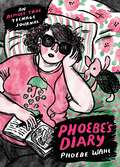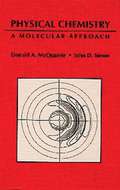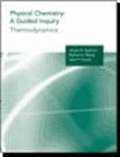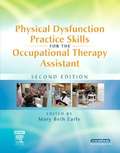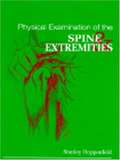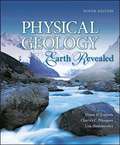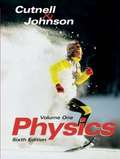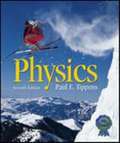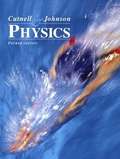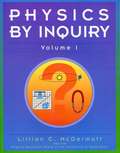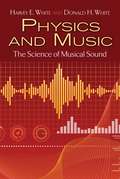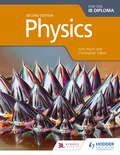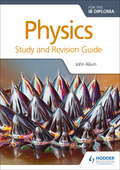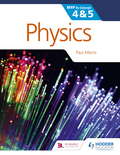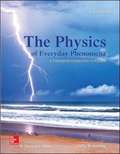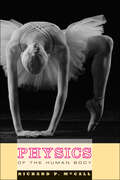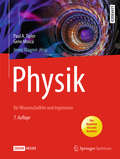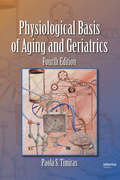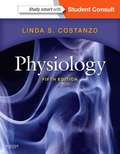- Table View
- List View
Philosophical Horizons: Introductory Readings
by Steven M. Cahn Maureen EckertExplores the central issues of philosophy through an engaging combination of classic and contemporary sources. With over seventy non-technical readings, the editors of PHILOSOPHICAL HORIZONS have put together the easiest to follow and yet most informative philosophy selections ever. Unlike any other introductory anthology, you can read fully annotated masterpieces from the history of philosophy in their entirety, including Plato's Euthyphro, Apology, and Crito, the Encheiridion of Epictetus, Descartes's Meditations, Berkeley's Treatise, Hume's An Enquiry Concerning Human Understanding and Dialogues Concerning Natural Religion, Kant's Groundwork, Mill's Utilitarianism, James's The Will to Believe, and Sartre's The Humanism of Existentialism. These are juxtaposed with related work from contemporary philosophers so that you can experience how the issues raised in these classic works of philosophy are debated in contemporary times.
Philosophical Letters, Abridged (Early Modern and Modern Women Philosophers)
by Margaret Cavendish"Margaret Cavendish (1623–1673) is a fascinating figure who is getting increasing attention by historians of philosophy these days, and for good reason. . . . She&’s an interesting advocate of a vitalist tradition emphasizing the inherent activity of matter, as well as its inherent perceptive faculties. She&’s also the perfect character to open students (and their teachers) up to a different seventeenth century, and a different cast of philosophical characters. This is an ideal book to use in the classroom. The Philosophical Letters (1664) gives us Cavendish&’s view of what was interesting and important in the philosophical world at that moment, a view of philosophy as it was at the time by an engaged participant. There are few documents like it in the history of philosophy. Deborah Boyle&’s Introduction provides a very accessible summary of Cavendish&’s natural philosophy, as well as good introductions to the other figures that Cavendish discusses in the book. Boyle&’s annotations are not extensive, but they are a great help in guiding the student toward an informed reading of the texts." —Daniel Garber, Princeton University
Philosophies of Art and Beauty: Selected Readings in Aesthetics from Plato to Heidegger
by Albert Hofstadter Richard KuhnsThis anthology is remarkable not only for the selections themselves, among which the Schelling and the Heidegger essays were translated especially for this volume, but also for the editors' general introduction and the introductory essays for each selection, which make this volume an invaluable aid to the study of the powerful, recurrent ideas concerning art, beauty, critical method, and the nature of representation. Because this collection makes clear the ways in which the philosophy of art relates to and is part of general philosophical positions, it will be an essential sourcebook to students of philosophy, art history, and literary criticism.
Philosophy and the Good Life
by Mark ArandiaPresents introductory readings by Plato, Hobbes, Nietzsche and other philosophers for a beginning student.
Philosophy of Science: A Contemporary Introduction (Third Edition)
by Alex RosenbergAny serious student attempting to better understand the nature, methods and justification of science will value Alex Rosenberg's updated and substantially revised Third Edition of Philosophy of Science: A Contemporary Introduction. Weaving together lucid explanations and clear analyses, the volume is a much-used, thematically oriented introduction to the field. New features of the Third Edition include more coverage of the history of the philosophy of science, more fully developed material on the metaphysics of causal and physical necessity, more background on the contrast between empiricism and rationalism in science, and new material on the structure of theoretical science (with expanded coverage of Newtonian and Darwinian theories and models) and the realism/antirealism controversy. Rosenberg also divides the Third Edition into fifteen chapters, aligning each chapter with a week in a standard semester-long course. Updated Discussion Questions, Glossary, Bibliography and Suggested Readings lists at the end of each chapter will make the Third Edition indispensable, either as a comprehensive stand-alone text or alongside the many wide-ranging collections of articles and book excerpts currently available. Read our interview with Alex Rosenberg, What exactly is philosophy of science - and why does it matter? here: www. routledge. com/u/alexrosenberg
Philosophy: A Text With Readings (Twelfth Edition)
by Manuel VelasquezEngaging and compelling on every page, Velasquez's text helps you explore and understand philosophy while it helps you appreciate the relevance of philosophy to your day-to-day life and the larger social world. This trusted text combines clear prose and primary source readings to take you on a meaningful exploration of a range of philosophical topics, such as human nature, reality, truth, ethics, the meaning of life, diversity, and social/political philosophy. Carefully crafted built-in learning aids help you quickly master the material and succeed in your course.
Phoebe's Diary
by Phoebe WahlINSTANT NATIONAL BESTSELLER! Take a peek inside Phoebe&’s Diary into a bracingly honest illustrated account of the explosive turmoil and joy of adolescence, based on the author&’s actual teenage journals. Meet Phoebe. She is cool and insecure, talented and vulnerable, sexy and awkward, driven and confused, ecstatic and tragic. Like you. And here is her diary, packed full of invaluable friends and heartbreaking crushes, spectacular playlists and vintage outfits, drama nerds and art kids, old wounds and new love. Based on her own teenage diary, Phoebe Wahl has melded truth with fiction and art with text, casting a spell that brings readers deep into the experience of growing up.
Physical Chemistry: A Molecular Approach
by Donald A. Mcquarrie John D. SimonThis book provides a contemporary approach to the study of physical chemistry. By beginning with quantum chemistry, students will learn the fundamental principles upon which all modern physical chemistry is built.
Physical Chemistry: Thermodynamics
by James N. Spencer Richard S. Moog John J. FarrellDesigned to encourage active and collaborative learning in the physical chemistry classroom, this text is a collection of group activities (ChemActivities) that can accompany any physical chemistry text.
Physical Dysfunction Practice Skills For The Occupational Therapy Assistant
by Mary Beth EarlyAimed at students training to become occupational therapy assistants, this textbook teaches key techniques designed to help patients to participate in personally selected and valued occupations. It is assumed that students have already completed basic anatomy and physiology and foundation OT courses. The second edition has been revised to conform to the AOTA's Occupational Therapy Practice Framework.
Physical Examination of the Spine and Extremities
by Stanley HoppenfeldUseful to students and clinicians, this text covers the process of physical examination of the spine and extremities.
Physical Geology: Earth Revealed, Ninth Edition
by Charles C. Plummer Diane H. Carlson Lisa HammersleyThe ninth edition has been updated to include the most current information from the various sub-disciplines that comprise physical geology. The book's purpose is to clearly present geologic processes so that students can understand the logic of scientific methods. This text features an outstanding art program and a proven, accessible writing style.
Physics (6th Edition)
by John D. Cutnell Kenneth W. JohnsonThis Sixth Edition helps readers understand the interrelationships among basic physics concepts and how they fit together to describe our physical world. Throughout the book, the authors emphasize the relevance of physics to our everyday lives. Real-world physics applications, including many biomedical applications, show how physics principles come into play over and over again in our lives. Problem Solving Insights explain each calculation in detail, guiding readers through the quantitative process Includes a CD containing physics simulations
Physics (7th Edition)
by Paul E. Tippens"Physics, Seventh Edition" is designed for the non-calculus physics course taken by students who are pursuing careers in science or engineering technology. Content is built through extensive use of examples with detailed solutions designed to develop students' problem-solving skills.
Physics (Fourth Edition)
by John D. Cutnell Kenneth W. JohnsonThe book facilitates both learning and teaching processes. It aims at helping students develop conceptual understanding and use it for solving problems in areas like Thermal Physics, Magnetism, Light, Optics, Modern Physics etc.
Physics By Inquiry: An Introduction to Physics and the Physical Sciences, Vol. 1
by Lillian C. Mcdermott Physics Education Group StaffThese volumes consist of a set of interactive based modules that offer a step-by-step introduction to physics and the physical sciences. Through an in-depth study of a few fundamental concepts, readers develop critical scientific reasoning skills. Volume 1 introduces basic physical ideas and includes topics which represent the essential background for the study of physical sciences.
Physics and Music: The Science of Musical Sound (Dover Books on Physics)
by Donald H. White Harvey E. WhiteThis foundational text is written for students who want to go beyond the perceptual stage of music to learn how musical sound is created and perceived. It surveys a wide range of topics related to acoustics, beginning with a brief history of the art and science of music. Succeeding chapters explore the general principles of sound, musical scales, the primary ways in which sound can be generated, the characteristics of instruments, the use of mechanical and electronic recording devices, hi-fi stereophonic and quadraphonic sound, the design of electronic musical instruments, and architectural acoustics.Comprehensive yet accessible, Physics and Music includes over 300 diagrams, photographs, and tables. Each chapter concludes with questions, problems, and projects, in addition to references for further study. 1980 edition.
Physics for the IB Diploma Second Edition
by Christopher Talbot John AllumProvide clear guidance to the 2014 changes and ensure in-depth study with accessible content, directly mapped to the new syllabus and approach to learning.This bestselling textbook contains all SL and HL content, which is clearly identified throughout. Options are available free online, along with appendices and data and statistics.- Improve exam performance, with exam-style questions, including from past papers- Integrate Theory of Knowledge into your lessons and provide opportunities for cross-curriculum study- Stretch more able students with extension activities- The shift to concept-based approach to learning , Nature of Science, is covered by providing a framework for the course with points for discussion - Key skills and experiments included - Full digital package - offered in a variety of formats so that you can deliver the course just how you like!
Physics for the IB Diploma Study and Revision Guide
by John AllumStretch your students to achieve their best grade with these year round course companions; providing clear and concise explanations of all syllabus requirements and topics, and practice questions to support and strengthen learning. - Consolidate revision and support learning with a range of exam practice questions and concise and accessible revision notes- Practise exam technique with tips and trusted guidance from examiners on how to tackle questions- Focus revision with key terms and definitions listed for each topic/sub topic
Physics for the IB MYP 4 & 5: By Concept
by Paul MorrisMYP by Concept is the only series for years 4 and 5 developed with the IB.Drive meaningful inquiry for the new framework through a unique concept driven narrative.- Supports every aspect of assessment with opportunities that use the criteria- Gives you easy ways to differentiate and extend learning- Provides a meaningful approach by integrating the inquiry statement in a global context- Develops critical-thinking skills with activities and summative sections rooted in the ATL frameworkAlso coming soon are Teaching and Learning Resources and eTextbooks via Dynamic Learning, our complete digital solution
Physics of Everyday Phenomena (Eighth Edition)
by W. Thomas Griffith Juliet W. BrosingThe Physics of Everyday Phenomena, Eighth Edition, introduces students to the basic concepts of physics using examples of common occurrences in everyday life. Intended for use in a one-semester or two-semester course in conceptual physics, this book is written in a narrative style, frequently using questions designed to draw the reader into a dialogue about the ideas of physics. This inclusive style allows the book to be used by anyone interested in exploring the nature of physics and explanations of everyday physical phenomena. Beginning students will benefit from the large number of student aids and the reduced math content. Professors will appreciate the organization of the material and the wealth of pedagogical tools.
Physics of the Human Body
by Richard P. McCallRichard P. McCall's fascinating book explains how basic concepts of physics apply to the fundamental activities and responses of the human body, a veritable physics laboratory. Blood pumping through our veins is a vital example of Poiseuille flow; the act of running requires friction to propel the runner forward; and the quality of our eyesight demonstrates how properties of light enable us to correct near- and far-sightedness. Each chapter discusses a fundamental physics concept and relates it to the anatomy and physiology of applicable parts of the body. Topics include motion, fluids and pressure, temperature and heat, speech and hearing, electrical behaviors, optics, biological effects of radiation, and drug concentrations. Clear and compelling, with a limited amount of math, McCall's descriptions allow readers of all levels to appreciate the physics of the human physique. Physics of the Human Body will help curious high school students, undergraduates with medical aspirations, and practicing medical professionals understand more about the underlying physics principles of the human body.
Physik
by Paul A. Tipler Gene Moscajenny WagnerDas Standardwerk in der rundum erneuerten Auflage - der gesamte Stoff bis zum Bachelor: jetzt auch mit spannenden Einblicken in die aktuelle Forschung! Verständlich, einprägsam, lebendig und die perfekte Prüfungsvorbereitung, mit unzähligen relevanten Rechenbeispielen und Aufgaben - dies ist Tiplers bekannte und beliebte Einführung in die Experimentalphysik. Klar und eingängig führt Tipler den Leser durch die physikalische Begriffs- und Formelwelt illustriert von unzähligen liebevoll gestalteten Farbgrafiken. Studienanfänger - egal, ob sie Physik im Hauptfach studieren oder ob es als Nebenfach auf dem Lehrplan steht - finden hier Schritt für Schritt den klar verständlichen Einstieg in die Physik mittels · Verständlicher Aufarbeitung des Prüfungsstoffes · Zahlreichen prüfungsrelevanten Übungsaufgaben · Anschaulichen Grafiken · Durchgehender Vierfarbigkeit · Übersichtlichem und farbkodiertem Layout · Ausgearbeiteten Beispielaufgaben, vom Text deutlich abgesetzt · Zusammenfassungen zu jedem Kapitel mit den wichtigsten Gesetzen und Formeln für jede Prüfung · Schlaglichtern, die aktuelle Themen aus Forschung und Anwendung illustrieren · Problemorientierter Einführung in die mathematischen Grundlagen. Aus dem Inhalt: Mechanik; Schwingungen und Wellen; Thermodynamik; Elektrizität und Magnetismus; Optik; Relativitätstheorie; Quantenmechanik; Atom- und Molekülphysik; Festkörperphysik und Teilchenphysik . Beispielaufgaben zum Nachvollziehen und zum selbst Üben vermitteln die notwendige Sicherheit für anstehende Klausuren und mündliche Prüfungen. Sämtliche Übungsaufgaben sind außerdem im Arbeitsbuch zu diesem Lehrbuch ausführlich besprochen und durchgerechnet. Erweitert wird der studienrelevante Inhalt um zahlreiche Kurzeinführungen in spannende aktuelle Forschungsgebiete verfasst von namhaften Forschern der deutschsprachigen Forschungslandschaft. Die Autoren Paul A. Tipler promovierte an der University of Illinois über die Struktur von Atomkernen. Seine ersten Lehrerfahrungen sammelte er an der Wesleyen University of Connecticut. Anschließend wurde er Physikprofessor an der Oakland University, wo er maßgeblich an der Entwicklung des Lehrplans für das Physikstudium beteiligt war. Inzwischen lebt er als Emeritus in Berkeley, California. Gene Mosca hat über viele Jahre Physikkurse an amerikanischen Universitäten (wie Emporia State, University of South Dakota, Annapolis) gegeben und Web-Kurse entwickelt. Als Koautor der dritten und vierten englischen Ausgabe hat er die Studentenmaterialien gestaltet. Jenny Wagner (Hrsg. ) . . . .
Physiological Basis of Aging and Geriatrics (Fourth Edition)
by Paola S. TimirasThis Fourth Edition offers a complete profile of the aging process at all levels, from molecules and cells to demography and evolution. The text includes aspects of individual, comparative, and differential aging, and discussions of theories and mechanisms of aging.
Physiology (Fifth Edition)
by Linda S. CostanzoThis book offers a comprehensive overview of core physiologic concepts at the organ system and cellular levels.
